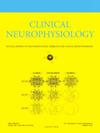未接受药物治疗的ADHD儿童的功能连接异常:诊断潜力、症状解释和中介模型
IF 3.7
3区 医学
Q1 CLINICAL NEUROLOGY
引用次数: 0
摘要
目的通过研究异常功能连接模式及其临床相关性,确定注意缺陷/多动障碍(ADHD)的可靠脑电图(EEG)生物标志物。方法收集74例6 ~ 12岁儿童静息状态脑电图数据(其中33例未用药;41 .典型发育)。使用相干虚部(ICOH)对功能连通性进行量化。基于机器学习(ML)的支持向量机(SVM)建模、回归和中介分析将连通性特征与症状严重程度和诊断分类联系起来。结果ADHD患儿额叶区(Fp2-F4、Fp1-Cz、F7-Cz) β (β)带低连通性,左侧顶叶-中枢网络(C3-P7、P3-P7等)θ (θ)带超连通性。SVM分类器使用三个连通性特征实现曲线下的平均面积为0.89。左顶叶θ带超连通性(C3-P7)与注意力不集中和多动/冲动均相关,并介导两者之间的相互关系。结论sadhd以额顶连通性中断为特征,感觉整合网络的θ波段超连通性可能补偿额叶调节功能受损。这些发现突出了C3-P7 θ带连通性作为诊断和机制的生物标志物,为神经反馈治疗提供了新的靶点,并增强了神经发育障碍的鉴别诊断。本文章由计算机程序翻译,如有差异,请以英文原文为准。
Functional connectivity anomalies in medication-naive children with ADHD: Diagnostic potential, symptoms interpretation, and a mediation model
Objective
To identify reliable electroencephalography (EEG) biomarkers for attention deficit/hyperactivity disorder (ADHD) by investigating anomalous functional connectivity patterns and their clinical relevance.
Methods
Resting-state EEG data were collected from 74 children aged 6–12 (33 unmedicated ADHD; 41 typically developing). Functional connectivity was quantified using the imaginary part of coherency (ICOH). Machine learning (ML)-based support vector machine (SVM) modeling, regression, and mediation analyses linked connectivity features to symptom severity and diagnostic classification.
Results
Children with ADHD exhibited beta (β) band hypo-connectivity in frontal regions (Fp2-F4, Fp1-Cz, F7-Cz) and theta (θ) band hyper-connectivity in left parietal-central networks (C3-P7, P3-P7, etc.). An SVM classifier achieved an average area under the curve of 0.89 using three connectivity features. Left parietal θ band hyper-connectivity (C3-P7) correlated with both inattention and hyperactivity/impulsivity and mediated their interrelationship.
Conclusions
ADHD is characterized by disrupted frontoparietal connectivity, with θ band hyper-connectivity in sensory-integration networks potentially compensating for impaired frontal regulation.
Significance
These findings highlight C3-P7 θ band connectivity as both a diagnostic and mechanistic biomarker, providing novel target for neurofeedback therapies and enhancing the differential diagnosis in neurodevelopmental disorders.
求助全文
通过发布文献求助,成功后即可免费获取论文全文。
去求助
来源期刊

Clinical Neurophysiology
医学-临床神经学
CiteScore
8.70
自引率
6.40%
发文量
932
审稿时长
59 days
期刊介绍:
As of January 1999, The journal Electroencephalography and Clinical Neurophysiology, and its two sections Electromyography and Motor Control and Evoked Potentials have amalgamated to become this journal - Clinical Neurophysiology.
Clinical Neurophysiology is the official journal of the International Federation of Clinical Neurophysiology, the Brazilian Society of Clinical Neurophysiology, the Czech Society of Clinical Neurophysiology, the Italian Clinical Neurophysiology Society and the International Society of Intraoperative Neurophysiology.The journal is dedicated to fostering research and disseminating information on all aspects of both normal and abnormal functioning of the nervous system. The key aim of the publication is to disseminate scholarly reports on the pathophysiology underlying diseases of the central and peripheral nervous system of human patients. Clinical trials that use neurophysiological measures to document change are encouraged, as are manuscripts reporting data on integrated neuroimaging of central nervous function including, but not limited to, functional MRI, MEG, EEG, PET and other neuroimaging modalities.
 求助内容:
求助内容: 应助结果提醒方式:
应助结果提醒方式:


